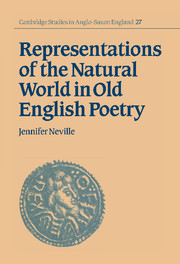Book contents
- Frontmatter
- Contents
- Acknowledgements
- List of abbreviations
- 1 Introduction: defining the natural world
- 2 Defining and confining humanity
- 3 Constructing society: outside and inside, powerlessness and control
- 4 Standing outside, standing out: defining the individual
- 5 Representing God: power in and against nature
- 6 Enclosing the natural world: knowledge and writing
- 7 Conclusion
- Bibliography
- Index
3 - Constructing society: outside and inside, powerlessness and control
Published online by Cambridge University Press: 29 September 2009
- Frontmatter
- Contents
- Acknowledgements
- List of abbreviations
- 1 Introduction: defining the natural world
- 2 Defining and confining humanity
- 3 Constructing society: outside and inside, powerlessness and control
- 4 Standing outside, standing out: defining the individual
- 5 Representing God: power in and against nature
- 6 Enclosing the natural world: knowledge and writing
- 7 Conclusion
- Bibliography
- Index
Summary
While the representation of the natural world can be seen to reflect the Anglo-Saxons' pessimistic view of the human condition generally, the use of negative or reverse traits in the depiction of monstrous races points toward the more specific and antagonistic roles that the natural world can play in Old English poetry: creatures like Grendel are not merely mirror images but negative forces, not merely different but destructive. The threat posed by the natural world thus appears to demand defensive postures and actions, to necessitate the forming of groups and structures within which humanity can live comparatively safely. However, as discussed earlier, what appears as the cause is more accurately understood as the effect: the Anglo-Saxons' conception of human society and its fragility leads to the representation of the natural world as a threat. By examining the representation of the natural world, we can observe Old English poets defining the purpose, creation and maintenance of their society.
Historians and archaeologists as well as literary critics have already gathered a great deal of information about Anglo-Saxon society – for example, about the heroic lord-thegn relationship that ideally formed the basis of society (according to literature, at least), about the rise and fall of dynasties, about settlement patterns, about the emergence of a concept of the English nation, about law codes and the developments in government caused by the technology of writing, about the roles of the church and about trade and the economy.
- Type
- Chapter
- Information
- Publisher: Cambridge University PressPrint publication year: 1999

